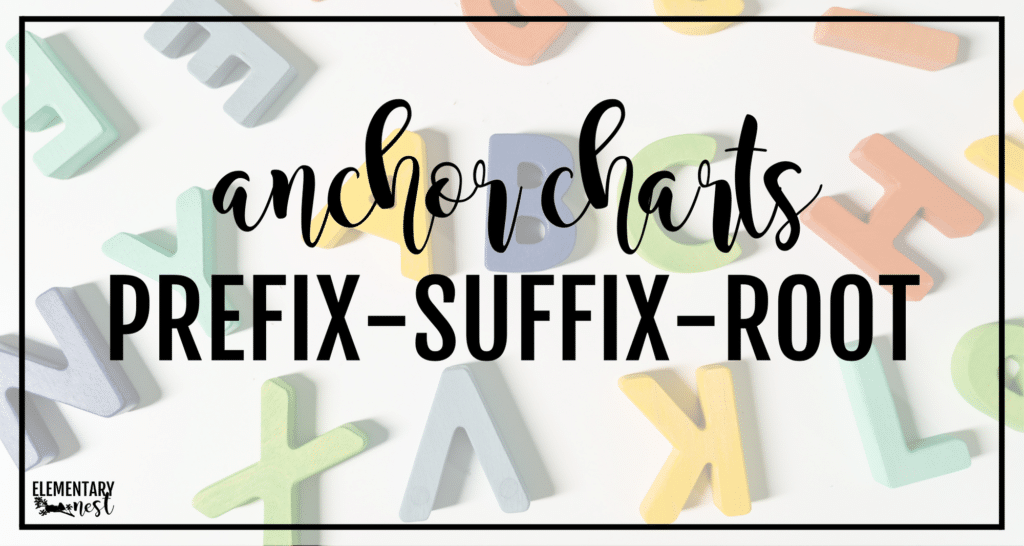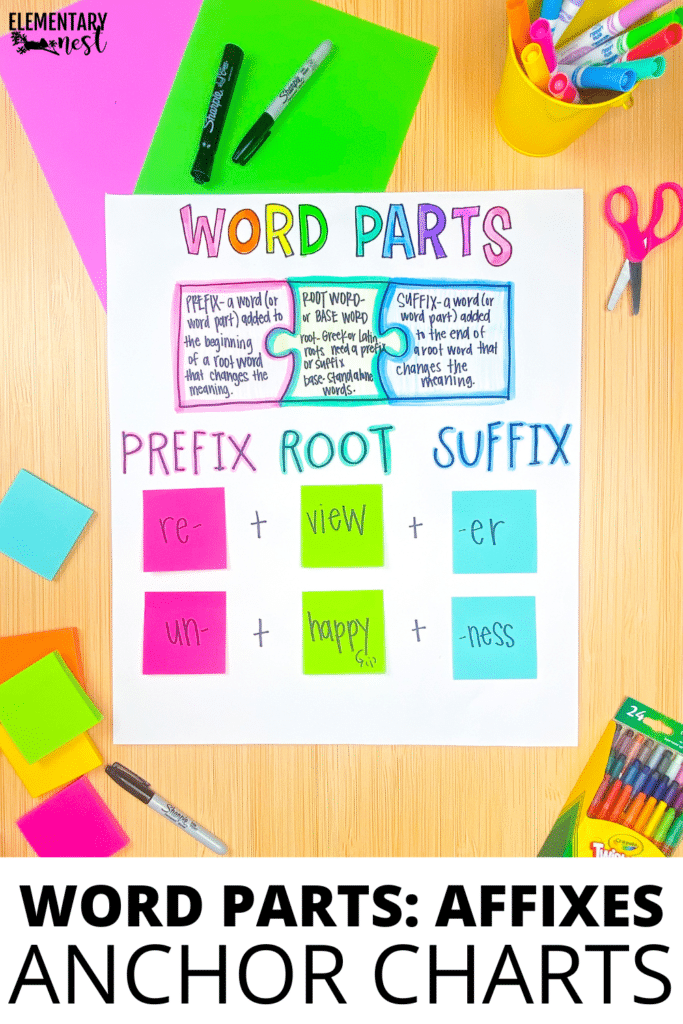
Welcome back to our blog series about teaching prefixes, suffixes, and root words! In today’s post, we will look at the 5 anchor charts you need to teach word parts.
Prefixes, suffixes, and root words are some of the fundamental building blocks of language. But these concepts can often be challenging for students to understand and remember. This is where anchor charts come in! By providing visuals alongside explanations of each concept, students will be better equipped to understand and retain this information.
Additionally, I would like to remind you how effective anchor charts can be when they are interactive. Including elements where students are able to become an interactive part of the learning process can vastly improve chances of retention!
An Anchor Chart for Introducing Word Parts

This first anchor chart is very simple. Students can clearly see the three parts of a word that you will be learning about. Using puzzle pieces or color coding can help students grasp the concept, too!
Your introductory anchor chart should include:
- Prefix- with definition and example
- Suffix- with definition and example
- Root- with definition and example
- Base- include with root, but clarify differences
- An interactive element that allows continuous use of anchor chart and provides opportunities for specific word part study. Students can learn prefixes (or suffixes) in chunks. So, one day you may focus on re- and un-. The next day you can switch out to mis- and pre-.
Anchor Charts for Prefixes and Suffixes


Next up, you are going to have anchor charts that list the prefixes and suffixes that your students need to master. This will vary dependent on your grade-level standards. However, a simple three-column chart should work well! Include a list of prefixes, their meaning, and examples that are within your students range of understanding! You can even have your students help create this one. If you’d like, you can include examples on mini post-its or create a laminated chart so that students can add to it with a dry-erase marker!
Your prefix/suffix anchor charts should include:
- Prefix/Suffix Label
- Prefix/Suffix Definition
- Three-Column Chart- Labeled (Prefix/Suffix, Meaning, Examples)
- List of Grade-Level Required Prefixes/Suffixes
- Short, Clear Meanings for each
- Two (or more) Examples of words that include the prefix/suffix (Be sure they are common and/or accessible to your students)
- Color-coding or Marking (like underlining or circling) for the prefix/suffix
Anchor Chart for Root Words

When your students are ready for root words, you can create one or two anchor charts. In the example above, the anchor chart is split into two with color-coded root words: Greek in purple, Latin in pink. However, if it makes more sense to you to have an anchor chart for each type, that works, too! The main function of learning about root words is not necessarily to be able to recall if they are Greek or Latin, though (at this age). You want students to remember the root meanings so that they can better use context to understand unknown words.
As with the prefix & suffix charts, you need a simple three-column chart. Be sure to include the root word, its meaning and a few accessible examples.
Anchor Charts for Skill Practice

Lastly, it is an effective practice to include interactive word building opportunities for mastering word parts. If you have younger students, create a simple version of the chart above. It is possible that your students will need to work on prefixes and suffixes separately in order to build their skills before approaching something that includes both affixes.
So, you will simply need a way to “exchange” word parts to create a collection of words that use affixes and root words. For example, you may have the prefix “re-” on a sticky note in the left column. Students can add and take away root & base words to create a collection of words that use that prefix. They can add: “play,” “do,” “place,” “write,” but if they added “whelm” or “want” they would take them away and not keep them on the stack.
Of course, you can repeat this activity with suffixes and root words! Each of these activity anchor charts can be easily adapted to your students needs. Be sure to check your grade-level standards and assess your students prior knowledge as you enter your word study unit!
Thank you so much for looking through my anchor chart ideas for teaching word parts. Check back in for the next post on Mentor Texts for Word Parts. Until then, happy teaching!
Resources That Are Ready to Go!
If you’re in search of resources that are ready to go, I have RF and L units with everything you need. From assessments to lesson plans, centers, and graphic organizers. Take a look at the standards you need teach below:



These RF units are complete and will help you teach prefixes, suffixes, and root words. Your students will be able to master the word attack and decoding skills they need to improve their reading fluency and accuracy.





Here are the Language units with a focus on Word Parts! These lessons and activities will offer opportunities for your students to improve their vocabulary skills and overall comprehension.















